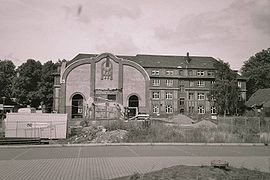Former pit Lothringen 1/2

The colliery Lothringen was a coal mine in Gerthe, a district of Bochum.
The colliery had altogether six pits. The pits 1, 2 and the ventilation shaft, (later named pit 6) were all located along the Lothringer Straße.
All of the pits were accessible via a plant-railway connection between the railway station Bochum-North and the railway Dortmund-Bövinghausen.
The shareholding trade union Lothringen, developed into a coal cooperation in the Ruhr area from 1872 onwards. The peak of the economic activity was in the 20ties of the past century. It was last owned by the Eschweiler Bergwerksvereins EBV.
During a mine explosion on the 8th of August 1912, 115 miners died in a depth of 350 metres. Safety deficiencies and insufficient ventilation was the course of the disaster. Emperor Wilhelm II stayed by a sheer coincident in the Ruhr area for the 100-year-celebration of Krupp and visited spontaneously the colliery to give his condolences to the survivors. For this, a history painting exists. At the time of the National Socialism 1933-1945, camps for forced labour were built on the terrain of the pit Lothringen, to ensure the required demand of the workforce.
In 1960, the colliery was taken over by Earl Schwerin and pit 1 of Lothrien expanded to a central winding shaft. At the height of the coal crisis in the second half of the 1960ties, the union Bergbau-AG Lothringen started to withdraw completely from the coal mining. Most parts of the collieries were sold to the Eschweiler Bergwerks-Verein (EBV). They continued the colliery or closed them down when the remaining service life didn't seem sufficient. On the 1st of January 1967, the amalgamated mine Lothringen/Graf Schwerin was closed down. One part of the claim came to the colliery Erin, which has also been bought by the EBV.
At the end of the 19th-century, the construction of housing for workers started, in order to draw and keep the needed workforce.
The impregnation unit of pit V, which was inaugurated in 1922, which impregnated mostly railway sleepers with tar oil and conserved construction wood with a special procedure, was still working till the late 1992, last by a subsidiary company of the Pfleiderer GmbH.
Seppel of the colliery Lothringen was the last German pit pony, which worked above ground till august 1966. It retired in Lüdinghausen.
The pits were backfilled and the above ground facilities taken down. The coking plant at Earl Schwerin 1/2 was still processing until 1975. The ventilation shaft 6 was still in operation till 1980. Of the pits 1/2/6 at the Lothringer Str, the administration, the machine buildings and the buildings of the ammonia factory are still iin very condition today. The covered pits 1 and 2 can be seen in front of the machine buildings. Pit 6 is located at the entrance of the administration.
At the pit facility 3, at the Oswaldstraße, there are still the washrooms, administration, transformer house, dressing rooms and some barracks of the former prison camp. The backfilled pit is only recognisable by a signboard.
Of pit 4 only the sheave still exists. A housing estates is being built north of the former pit. An industrial park is planned on the remaining terrain. The contaminated soil through the coking plant has been pushed together into a mound and sealed.
Pit 5 is situated at the Castroper Hellweg. Here stood, until 2011, the machine house with the covered pit and two other buildings and boiler, which were visibly in a very bad state. The terrain was fenced and not accessible. Beginning of the year 2011, the redevelopment of the substantial contaminated site started to establish an industrial park.
(The German text stem from the article http://de.wikipedia.org/wiki/Zeche_Lothringen from the Free Encyclopedia Wikipedia).

